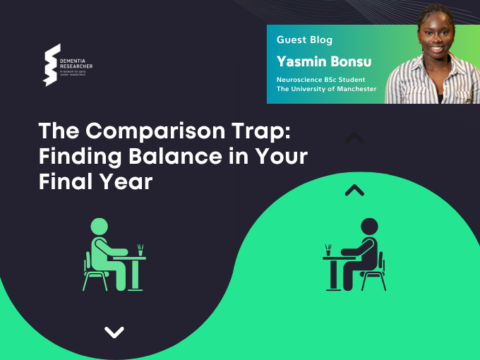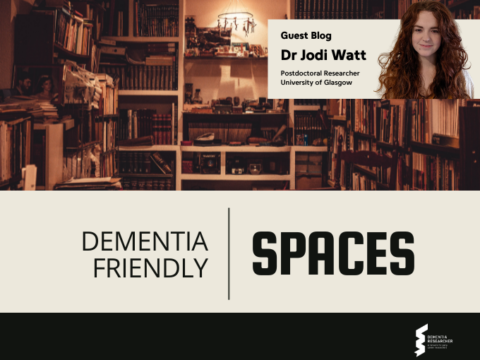I am in awe of the power of medications – the fact that so many exist, the processes that have gone into developing even one of them, that things people would have died from in recent history can be nigh-on mitigated by a simple tablet once a day.
Currently, I work in a post-doc position adjacent to drug development, where I try to identify target drugs for repurposing that are already in regular use for other medical indications. Simply put, drug repurposing is as it sounds, you find a new use for a drug intended for something else. A great example of this is sildenafil, which you may know better as Viagra. It was originally investigated for use in hypertension and angina, but in their clinical trials they realised it caused erections and then marketed it as such. For those of you who don’t work in this area, there are a few specific advantages to drug repurposing that fuel attempts to do so in dementia: the safety, pharmacokinetics and toxicology are already known, development costs are significantly less, and the time to market can be far quicker than traditional drug development.
Whilst I have a research focus on repurposing, I am ultimately keen for a drug which works well to come to market as quickly as is practicable, whether that’s via repurposing or traditional drug development. If you’re perusing Dementia Researcher, I’m sure it won’t be news to you that there’s been some massive progress in the world of dementia drug development over the past couple of years, and quite rightly, many people are incredibly excited about what this means. In fact, some people are so excited, that when I was doing my regular Googling to see what’s new in my research field, I came across a question that caught my eye in the “People also ask” section of my search results – “What is the miracle drug for dementia?” Ahhhh. Drug developments in this field are breaking ground at quite the pace at the moment, and incredibly promising, but they aren’t miracle fix-alls that will solve everything, for everyone.
Before I go too far down this road, I want to acknowledge explicitly that I’m excited too, of course I am. As aforementioned, I love medications and their life-changing effects. But, I think it is crucially important that, as dementia researchers, we recognise the inequity of the medications that we are developing. Yes, we are making great leaps in where we are at with drug development, but if such leaps are not taken with the rich diversity of those who may need this drug in future taken into account, how much of a leap is this really? That’s a bit of a purposefully baiting question, my apologies, but I still think it’s important to recognise that a person living with dementia is not a monolith, or a stereotype, or indeed someone deserving of a ‘one-size-fits-all’ approach.
The optimal scenario for me, and presumably everyone else working in the field, is that as soon as is possible and practicable, we can have a drug (from a selection of multiple drugs for different clinical presentations) which is suitable for every person who requires it, across the globe. However, inequitable approaches to drug development are getting in the way of that, somewhat.
Bluntly, if you are a ‘healthy’ (per the definition of a given clinical trial), cisgender, Caucasian male, we know most about you and how any drugs we are considering or developing work in you. Despite female people being more likely to develop dementia, we don’t tend to put them in clinical trials, particularly in the earlier phases, at least historically. This is getting better, but we are playing catch up with the information that we have about sex differences in dementia – for example, whether there is a possible link between dementia and menstruation or menopause is something for which investigation has only just begun in recent years. And we haven’t even begun to touch on how non-cisgender identities and related medical transition may affect how we manage dementia in these populations.

On average, drug repurposing can reduce development costs by up to 60% and bring a drug to market in about 6.5 years, compared to the 10-15 years typically required for new drug development.
Compared to what we know of dementia and related conditions in Caucasian individuals, we don’t know a lot about what it looks like in non-white populations. However, research strongly suggests that people from racial and ethnic minority groups are at greater risk of cardiovascular issues than their Caucasian counterparts, and we know that cardiovascular health (or rather, ill-health) is a strong risk factor for dementia. As such, this is often a comorbidity at play when considering drug development or repurposing and is imperative to consider when we try to identify suitable old drugs or create new ones. However, despite having this information, other parts of the system fall down when it comes to diagnosing and managing dementia – Black and Hispanic people are significantly more likely than Caucasian people to have dementia of some kind, but also far less likely to actually be diagnosed [1]. Furthermore, non-Caucasian people living with dementia are less likely to be referred to specialists [2], which is particularly pertinent to drug access inequity, as such specialists often need to be liaised with to enable access to such drugs. And the development of such drugs? Well, only 20% of individuals in the lecanemab trial, and less than 10% in the donanemab trial, were people of colour [3,4].
If we consider other protected characteristics, disabilities and dementia is a huge topic area worthy of its own series of blog posts. However, just as an example, people with learning disabilities are more likely to get dementia at a younger age, and those with Down’s syndrome have a much higher lifetime risk that people who do not have a learning disability [5]. They are a group requiring of anti-dementia drugs, often earlier than many other groups, but their disability often excludes them from inclusion in clinical trials. More broadly, a recent review investigated ‘being disabled’ as an exclusion criteria in clinical trials, and evidenced high rates of exclusion and ill-defined criteria [6].
Geography can also play a huge part, both in terms of access practicalities and location-related socio-economics. As someone working and living in Scotland, I know all too well how much of an issue physical access to specialised and specific healthcare can be. If we take the idea of a remotely-based islander requiring e.g. lecanemab, that likely would necessitate a trip to the mainland, often ultimately a very long trip. That’s if the trip can even happen, if the weather is too poor to leave the island, or the person living with dementia is unable to make the trip. And if it wasn’t necessary to get to the mainland for the administration of the drug, it certainly would be for the imaging monitoring required. This is just locally, within my Scotland-centric lens. Within the UK, we see that people who are considered to be more deprived (as often measured by the Townsend Deprivation Index) are less likely to be prescribed anti-dementia drugs [7, 8], which can be, in part, due to their geographic location within the country.
If we take that to a global stage, we end up with a far more complicated picture of global drug access, fraught with differences in global politics and regulations. If we take two of the behemoths in the drug development sphere – the UK and the United States – even these two face different issues in drug access, and particularly highlight the socio-economic complexities. The UK has been dealing with years of NHS under-funding, which potentially puts a question mark over the financial feasibility of using a new drug for all individuals who meet criteria. In contrast, the United States does not have universal healthcare, complicating concerns around cost-based access, i.e. newly-developed drugs only being available to those who can afford it. Per the World Health Organization, around 1/3 of the world’s population don’t have reliable access to essential medicines, never mind the latest in cutting-edge drugs. Yet, dementia is a condition of global concern, with more than 60% of people with dementia living in low- and middle-income countries.
The picture looks a bit different when we try repurposing drugs, particularly those that are older and therefore off-patent – they can be cheaper, and although many were developed in white cisgender male cohorts, time and experience has anecdotally informed us about how these drugs fare in other populations, at least when used for their original purpose. However, these still have to be tested for their new proposed use, and this is then subject to the same issues with inclusive recruitment to clinical trials that I’ve mentioned previously here and in some of my other posts.
In summary, inequity touches across every stage of our research processes, whether your research focus is drugs or not, and we all have a responsibility to remain cognizant of such issues and work to create a shift. Each person who presents with dementia has their own unique identity, which may contribute positively or negatively to their access to anti-dementia drugs, and it is critical to consider how these may be addressed and current situations improved to enable truly equitable drug development. A lot of the major players in drug development and the adjacent worlds know and care a lot about this, which is reassuring, but if we make leaps and bounds for one group of people, we should be careful that we don’t leave others behind.
- Lennon, J.C., Aita, S.L., Bene, V.A.D., Rhoads, T., Resch, Z.J., Eloi, J.M. and Walker, K.A., 2022. Black and White individuals differ in dementia prevalence, risk factors, and symptomatic presentation. Alzheimer’s & Dementia, 18(8), pp.1461-1471.
- Lewis, A., Gupta, A., Oh, I., Schindler, S.E., Ghoshal, N., Abrams, Z., Foraker, R., Snider, B.J., Morris, J.C., Balls-Berry, J. and Gupta, M., 2023. Association between socioeconomic factors, race, and use of a specialty memory clinic. Neurology, 101(14), pp.e1424-e1433.
- Van Dyck, C.H., Swanson, C.J., Aisen, P., Bateman, R.J., Chen, C., Gee, M., Kanekiyo, M., Li, D., Reyderman, L., Cohen, S. and Froelich, L., 2023. Lecanemab in early Alzheimer’s disease. New England Journal of Medicine, 388(1), pp.9-21.
- Sims, J.R., Zimmer, J.A., Evans, C.D., Lu, M., Ardayfio, P., Sparks, J., Wessels, A.M., Shcherbinin, S., Wang, H., Nery, E.S.M. and Collins, E.C., 2023. Donanemab in early symptomatic Alzheimer disease: the TRAILBLAZER-ALZ 2 randomized clinical trial. Jama, 330(6), pp.512-527.
- Lott, I.T. and Head, E., 2019. Dementia in Down syndrome: unique insights for Alzheimer disease research. Nature Reviews Neurology, 15(3), pp.135-147.
- Camanni, G., Ciccone, O., Lepri, A., Tinarelli, C., Bedetti, C., Cicuttin, S., Murgia, N. and Elisei, S., 2023. ‘Being disabled’as an exclusion criterion for clinical trials: a scoping review. BMJ Global Health, 8(11), p.e013473.
- Cooper, C., Lodwick, R., Walters, K., Raine, R., Manthorpe, J., Iliffe, S. and Petersen, I., 2016. Observational cohort study: deprivation and access to anti-dementia drugs in the UK. Age and ageing, 45(1), pp.148-154.
- Vohra, N., Hadi, M.A., Khanal, S., Kurmi, O.P. and Paudyal, V., 2021. Impact of deprivation, dementia prevalence and regional demography on prescribing of antidementia drugs in England: A time trend analysis. British Journal of Clinical Pharmacology, 87(10), pp.3747-3755.

Jodi Watt
Author
Dr Jodi Watt is a Postdoctoral Researcher at University of Glasgow. Jodi’s academic interests are in both healthy ageing and neurodegenerative diseases of older age, and they are currently working on drug repurposing for dementia. Previously they worked on understanding structural, metabolic and physiological brain changes with age, as measured using magnetic resonance imaging. As a queer and neurodiverse person, Jodi is also incredibly interested in improving diversity and inclusion practices both within and outside of the academic context.

 Print This Post
Print This Post




